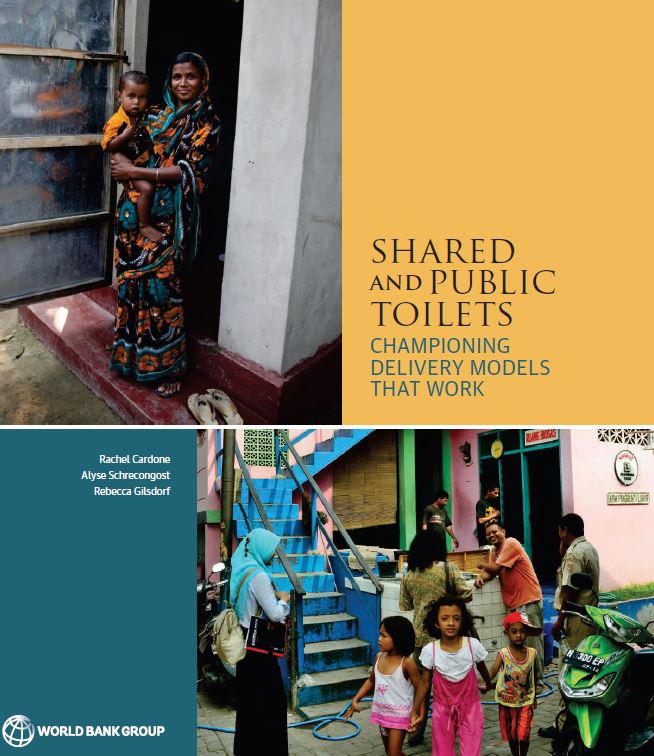Shared and Public Toilets: Championing Delivery Models that Work
The Sustainable Development Goals (SDGs) call for universal sanitation access and ending open defecation by 2030. Shared toilet models are not currently an acceptable form of safely managed sanitation. The ambition for the goals is thus set against an urban reality where hundreds of millions of people regularly rely on shared toilet models, but aren’t counted, and where policy makers lack incentives to support shared toilet models, even when these are more suitable, for technical and geographic reasons. The alternative to not having any form of sanitation is open defecation, with associated human and environmental health impacts. The logic behind the exclusion of shared toilet models is that they fail to deliver safe sanitation services to their users. For example, there is evidence that health outcomes from shared models are worse than from individual household toilets. The market structure and underlying dynamics that cause shared toilet models to succeed or fail are messy and often context specific, which makes shared toilet models hard to justify at a global level. Still, there are examples where shared toilet models can and do work and are preferable to individual household toilets. Often, models that provide safely managed sanitation have evolved through deep community engagement, iterative experimentation with facility design, adaptation of the delivery model to meet user needs and preferences over time, and reliance on a financially viable revenue model. This document aims to inform early considerations and decisions that planners and policy makers must weigh when considering whether and how to pursue shared toilet models as an improvement to the status quo or how to improve existing shared toilet models. The intended audience is policy makers and others who are tasked with improving urban sanitation and advancing citywide inclusive sanitation (CWIS) but who may not have extensive experience working on these issues. It includes an overview of shared toilet models, brief examples, checklists, high-level decision trees, and tips based on research and experience. It is accompanied by a series of appendixes, which offer a summary of findings from a literature search, additional graphics, and a checklist of things to consider when planning, implementing, and managing shared toilet models. It is built on an assumption that with an experimental mindset and operational flexibility to innovate, shared toilet models can offer safe sanitation services as part of CWIS and contribute meaningfully to the SDGs. Notably, this document does not explicitly address container-based sanitation service models, which are evolving to meet urban sanitation needs for shared and individual household situations. This topic is the subject of a separate World Bank report titled Evaluating the Potential of Container-Based Sanitation (forthcoming). Nor is this document a stepwise guide to implementing shared toilet models, considering legal, regulatory, policy, financial, technical, and social issues.1 Rather, it offers a pragmatic introduction to the starting questions a policy maker or planner should ask. Report Structure Because of the diversity of approaches used to deliver sanitation services, and the corresponding diversity of needs and enabling environments, shared toilet models were considered from four perspectives: • The context in which sanitation services are needed • Toilet users’ needs, including urban residential use and the varying needs of users as they move around the city throughout each day • Service providers, who provide cleaning and maintenance services of shared household, community, and public toilets and sometimes the infrastructure and financing for the facilities Service authorities, or the government entities responsible for ensuring that services are provided and basic sanitation needs are met For each of these perspectives, opportunities and challenges are presented, and questions to consider in decision making are prompted. Where possible, these are distilled into high-level decision frameworks, using decision point indicators shown in figure 1.1. Other features offering context and support—summarized in figure 1.2—include high-level checklists, tips, case studies, and references to tools and resources. These features are meant to briefly flag or illustrate important points and direct the reader to additional information sources, rather than offering a comprehensive and exhaustive guide. Key Findings and Emerging Ideas about Shared Toilet Models The following is a brief summary of findings, drawing from an extensive literature survey. A longer analysis of findings is provided in appendix B; literature surveyed is provided in appendix E. Individual household toilets Individual household toilets (IHHTs) are, in general, a preferred toilet choice for residential settings (Norman 2011) and lend themselves best to continued operation and management, which is better for privacy, dignity, and public health. To the extent IHHTs can be pursued to meet the basic sanitation needs of residential households, they should be. However, IHHTs are not technically feasible in many low-income, urban communities. IHHTs are not suitable in areas with extremely high population density, where there is no space in basic housing structures, and where multiple households cohabitate and overwhelm IHHT design capacity. Standard designs are less feasible in areas with high water tables or bedrock, where creating a safe containment space for fecal sludge is cost prohibitive for households, service providers, and service authorities. Where IHHTs are not connected to a sewer, complementary containment infrastructure and access to a full fecal sludge management chain (in essence, service for emptying and transporting contained waste, as shown in figure 2.2) is a necessary precondition for viability
